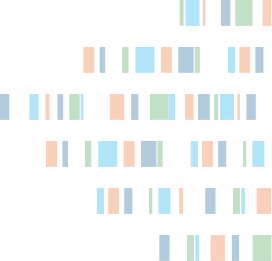The Evolution of Next-Generation Sequencing:
Five Key Growth Areas
Accelerating research with targeted sequencing
Next-generation sequencing (NGS) continues to revolutionize genomic research, expanding into diverse scientific disciplines with transformative impacts. While whole-genome sequencing provides comprehensive genetic information, targeted next-generation sequencing enables researchers to focus their sequencing efforts on specific genomic regions of interest rather than the entire genome. This approach dramatically reduces sequencing costs while increasing data quality and simplifying analysis, making it amenable for projects requiring high sensitivity or working with challenging samples. As research demands grow more specialized, targeted sequencing solutions have become essential tools.
Hybridization capture emerges as a robust method within targeted sequencing, utilizing biotinylated oligonucleotide probes to selectively enrich specific DNA sequences from complex samples. This method provides unprecedented flexibility to interrogate a breadth of targets with high specificity.1
myBaits® technology: precision targeting for complex applications
At the forefront of targeted sequencing, Arbor Biosciences’ myBaits hybridization capture technology provides researchers with customizable solutions for precise genomic targeting. myBaits technology enables superior on-target specificity while maintaining target molecule complexity. The myBaits system product line offers a comprehensive suite of kit types, ranging from custom panel design to pre-designed kits targeting conserved elements.
The system’s versatility supports diverse applications across an increasing number of research fields, accommodating various sample types from fresh tissue to degraded specimens. With compatibility across all major NGS platforms and library preparation methods, myBaits technology provides researchers with a flexible tool that can be integrated into any genomic workflow.
Five key growth areas in targeted next-generation sequencing
Targeted sequencing approaches are driving scientific innovation. Here, we highlight how the myBaits system is being used in five areas showing particularly significant growth.
1. Agrigenomics: enhancing crop improvement and sustainable agriculture
Targeted sequencing has become instrumental in agricultural genomics, enabling researchers to identify genetic markers associated with desirable traits in crops and livestock. This approach accelerates breeding programs by focusing on specific genomic regions linked to disease resistance, yield improvement, and environmental adaptation.
Researchers working on barley genomics utilized myBaits technology to develop a targeted sequence capture system to identify genetic sequence variants across 174 flowering time-related genes in barley varieties. This targeted approach enabled them to efficiently analyze genetic diversity across diverse barley varieties, while avoiding the complexity of the barley genome, and achieve a high mean depth coverage of approximately 25x.2
2. Metagenomics: exploring microbial community complexity
Metagenomic analysis presents unique challenges due to the diversity of organisms in biological and environmental samples. Targeted sequencing provides an efficient solution by focusing on specific taxonomic markers or functional genes, enhancing the ability to reveal the full microbial diversity in complex samples.
A study using 16S rRNA target enrichment demonstrated how myBaits hybridization capture technology can significantly improve microbial community characterization. The researchers reported an increased proportion of 16S rRNA sequences by more than 400-fold compared to conventional shotgun metagenomic methods.3
3. Microbial research: pathogen detection and strain identification
In microbial research, targeted sequencing enables precise identification of pathogens and detailed strain typing, proving particularly valuable when target organisms are present in low abundance or when host DNA dominates the sample.
Hybridization capture is especially powerful for detecting and characterizing pathogens in complex matrices like clinical specimens, environmental samples, or host tissues. By enriching pathogen DNA that would otherwise be overwhelmed by host sequences, researchers are able to detect low-level pathogens more reliably.
4. Evolutionary biology: uncovering genetic relationships
Evolutionary biologists increasingly rely on targeted sequencing to resolve phylogenetic relationships and investigate adaptive mechanisms across diverse species. By focusing on carefully selected genomic regions, researchers can generate robust phylogenetic datasets.
One group utilized the myBaits system in their global study of Mimosoid legumes to unveil fundamental evolutionary patterns. By enriching 997 nuclear genes, they discovered that precipitation primarily drives phylogenetic turnover within continents, with species diversification largely occurring within specific precipitation niches.3
5. Clinical NGS: advancing precision medicine
In clinical settings, targeted sequencing enables focused analysis of disease-associated genes, supporting precision medicine approaches that tailor treatments to individual genetic profiles. This methodology is being increasingly leveraged in cancer diagnostics, rare disease identification, and pharmacogenomic applications.
The clinical utility of targeted sequencing extends to methylation analysis, where disease-specific methylation patterns serve as biomarkers for early detection and monitoring. Technologies like the myBaits Methyl-Seq system enable researchers to investigate methylation patterns with unprecedented precision, opening new avenues for non-invasive diagnostics and providing crucial insights into epigenetic regulation in various diseases.
Empowering research through targeted approaches
As next-generation sequencing continues to evolve, targeted approaches will remain essential for maximizing research efficiency and enabling discoveries across diverse scientific fields. By focusing sequencing efforts on specific regions of interest, technologies like the myBaits systems empower researchers to achieve deeper insights while optimizing resources, driving innovation across the genomic landscape.
References:
- Singh, R. “Target Enrichment Approaches for Next-Generation Sequencing Applications in Oncology” Diagnostics. (2022) Jun; 12(7). doi: 10.3390/diagnostics12071539
- Hill, C. et al. “Targeted enrichment by solution-based hybrid capture to identify genetic sequence variants in barley.” Scientific Data. (2019) Apr; 6(12) doi: 10.1038/s41597-019-0011-z
- Beaudry, M. et al. “Improved Microbial Community Characterization of 16S rRNA via Metagenome Hybridization Capture Enrichment.” Frontiers in Microbiology. (2021) Apr12:644662. doi: 10.3389/fmicb.2021.644662
- Ringelberg, J. et al. “Precipitation is the main axis of tropical plant phylogenetic turnover across space and time” Science Advances. (2023) Feb 9(7) doi:1126/sciadv.ade4954


 Bluesky
Bluesky